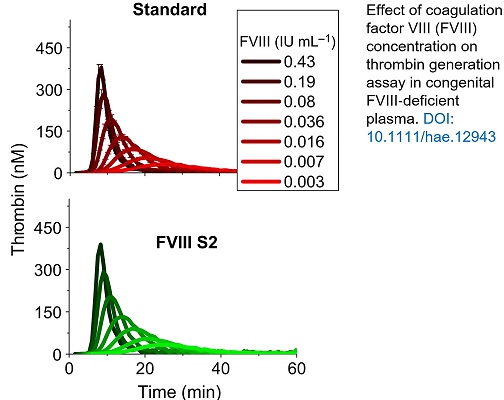Study of the regulation of blood coagulation by factors VIIa and IXa
Mikhail V. Ovanesov, Ph.D.
Office of Tissues and Advanced Therapies
Division of Plasma Protein Therapeutics
Hemostasis Branch
Biosketch
Dr. Ovanesov is a biophysicist who joined the Laboratory of Hemostasis, Office of Blood Research and Review in 2009 as a regulatory scientist and principal investigator. He has studied blood coagulation since 1998 and has interdisciplinary experience in biochemistry, neurovirology, and the design of biomedical instruments.
Dr. Ovanesov received his Ph.D. degree in biochemistry and biophysics from the National Research Center for Hematology in Moscow, Russia followed by postdoctoral fellowships at the Laboratory for Biomedical Sciences of the American Red Cross in Rockville, MD, Johns Hopkins University Medical School in Baltimore, MD, and Janelia Farm Research Campus of the Howard Hughes Medical Institutes in Ashburn, VA.
Dr. Ovanesov conducts expert regulatory review of Investigational New Drug (IND) submissions and Biologics License Applications (BLA) for blood plasma-derived and recombinant plasma protein products, lyophilized human plasma, gene therapies for hemophilia, and related devices. He serves as the product reviewer and Committee Chair on original BLA submissions and participates in the inspections of manufacturing facilities.
His laboratory at CBER develops biological reference standards and novel hemostasis assays, and investigates mechanisms of action of procoagulant therapeutics.
General Overview
CBER regulates products that prevent life-threatening blood loss in individuals who lack certain proteins that the body uses to coagulate blood (form clots). These products include coagulation factor VII (activated), factor IX, and factor XI.
Blood coagulation is a complex, multi-step process that requires many different coagulation factors. These factors must work together in a coordinated sequence to produce a blood clot when there is damage to the blood vessels. The clotting process can be fast and efficient; however, if left unchecked, clotting can lead to thrombosis (excessive clotting that blocks blood flow). Further, clotting is controlled by a dynamic system of coagulation proteins, called inhibitors. When the delicate balance between clotting (pro-coagulation) and inhibition (anti-coagulation) tips to one side or another, the result can be life-threatening thrombosis or spontaneous bleeding.
Our laboratory refines the tests used by clinical laboratories and drug manufacturers to determine the potency of coagulation factor concentrates. We share our methods with industry and regulatory agencies to ensure that these products remain safe and effective. Our analytical methods facilitate the review of new products engineered with properties that are different from those of natural coagulation factors. The methods and international standards developed in our laboratory also help clinical laboratories and manufacturers to standardize the monitoring of treatment effectiveness in patients who suffer from these devastating conditions.
To improve coagulation testing, we develop new methods that better represent the complexity of the blood coagulation system. Currently available tests used to diagnose blood coagulation disorders represent only individual steps of the complex process. Such tests can diagnose the lack of one specific coagulation factor or inhibitor in a patient’s blood, but cannot indicate the state of balance between the pro- and anti-coagulant systems. New tests are thus needed to assess the severity of the disease in patients, monitor the treatment to determine its effectiveness, or predict adverse events of treatment, such as excessive clotting in a bleeding patient. Our laboratory is working on new tests that reflect the current knowledge of the action of existing and developing coagulation factor products.
One such test, the Thrombin Generation Test, allows for the continuous monitoring of the pro- and anti-coagulation events over a long period of time in several plasma samples simultaneously. We also study clotting using a video-microscope, which records the growth of clot size in an artificial model of a blood vessel injury.
These new tests helped us investigate the link between acute thrombotic events (stroke and heart attack) and common contaminants in plasma-derived therapies, such as factor IX concentrates and immune globulin products. We found that thrombotic events may happen as an adverse reaction to administration of contaminated therapy.
In our work, we bring together the state-of-the art models of blood coagulation with new laboratory methods to improve the safety of regulated products. Ultimately, our results help improve the control over product quality and prevent distribution of potentially unsafe medicines to patients.
Scientific Overview
Imbalance in the blood coagulation system can cause life-threatening thrombosis and bleeding. Unfortunately, existing assays of blood coagulation function have poor predictive value for many pathological states and are not useful for diagnosis and monitoring treatment. We believe that coagulation testing can be improved by assessing physiological processes that are not represented by traditional assays. We are developing tests based on recent discoveries that clarify the biological activity of existing and emerging coagulation factor products. The use of these tools will improve the treatment of, and care received, by patients suffering from blood coagulation disorders.
The potential benefits and risks of existing and emerging blood coagulation-related products should be studied with assays that are physiologically relevant. Our research on blood clotting mechanisms will provide the basis for developing better coagulation testing and assay validation. The knowledge gained from our research helps with the evaluation of blood coagulation products to ensure their efficacy, safety, and high quality.
Our research program is designed to further our understanding of the clotting mechanisms through the use of novel assays that measure the global coagulation function. The thrombin/fibrin generation and video-microscopy-based clot growth techniques can evaluate many aspects of blood coagulation as it occurs in vivo; for example, activation with low levels of physiological trigger, gradual changes in enzymatic activity and clotting, and limited dilution of test plasma. However, these new assays are not yet optimized or validated specifically for determining the potency of coagulation factors, and thus validation of these tests is one of our research goals.
Another goal is the elucidation of activated factors VII, IX and XI as regulators of hemostasis and thrombosis. The licensed dose of factor VIIa exceeds its physiological level by several orders of magnitude; yet the treatment is safe in the target population of hemophilia patients with inhibitory antibodies to factors IX and VIII. In contrast, even trace amounts of factor IXa in factor IX concentrates or factor XIa in plasma-derived immune globulin products can result in serious thrombotic adverse events. To better understand the mechanisms of action of these molecules, we are investigating analytical conditions that can predict the duration of their clinical effect in vivo. These studies help in the evaluation of the safety and efficacy of products that treat disorders in blood coagulation.
Improving our understanding of how the balance of the blood coagulation process is maintained aids in the regulatory assessment of current products and emerging treatments, many of which are genetically or chemically engineered to have novel and unique biochemical characteristics.
Important Links
- Innovation and Regulatory Science- Scientific Poster: Evidence for a Link between an Immune Globulin Product and Thrombosis
- FDA-TRACK Program Areas: Collaborate in the development of a standardized Factor XIa reference reagent for Immune Globulin Thrombogenicity Testing
- FDA Public Workshop on Risk Mitigation Strategies to Address Potential Procoagulant Activity in Immune Globulin Products
- FDA Public Workshop on Product Development in Hemophilia
- Guidance for Industry on Human Gene Therapy for Hemophilia
- Guidance for Industry: Considerations for the Development of Dried Plasma Products Intended for Transfusion
- ORCID ID: 0000-0003-2509-1781
Publications
- Res Pract Thromb Haemost 2020 Jun 12;4(5):944-5
Effect of pH on thrombin activity measured by calibrated automated thrombinography.
Jackson JW, Surov SS, Liang Y, Parunov LA, Ovanesov MV - Blood Adv 2019 Sep 10;3(17):2668-78
Mitigation of T-cell dependent immunogenicity by reengineering factor VIIa analogue.
Jankowski W, McGill J, Lagasse HAD, Surov S, Bembridge G, Bunce C, Cloake E, Fogg MH, Jankowska KI, Khan A, Marcotrigiano J, Ovanesov MV, Sauna ZE - J Thromb Haemost 2019 Apr;17(4):695-7
Establishment of the WHO 2nd International Standard Factor V, plasma (16/374): communication from the SSC of the ISTH.
Hubbard AR, Thelwell C, Rigsby P, Subcommittee on Factor VIII, Factor IX and Rare Coagulation Disorders - Cell Mol Life Sci 2018 Oct;75(20):3781-801
Dissecting the biochemical architecture and morphological release pathways of the human platelet extracellular vesiculome.
De Paoli SH, Tegegn TZ, Elhelu OK, Strader MB, Patel M, Diduch LL, Tarandovskiy ID, Wu Y, Zheng J, Ovanesov MV, Alayash A, Simak J - Haemophilia 2017 May;23(3):466-75
Can the diagnostic reliability of the thrombin generation test as a global haemostasis assay be improved? The impact of calcium chloride concentration.
Parunov LA, Surov SS, Liang Y, Lee TK, Ovanesov MV - Am J Hematol 2017 Apr;92(4):E44-5
Association of immune globulin intravenous (IGIV) and thromboembolic adverse events (TEEs).
Ovanesov MV, Menis MD, Scott DE, Forshee R, Anderson S, Bryan W, Golding B - J Thromb Haemost 2017 Apr;15(4):709-20
Expression and characterization of a codon-optimized blood coagulation factor VIII.
Shestopal SA, Hao JJ, Karnaukhova E, Liang Y, Ovanesov MV, Lin M, Kurasawa JH, Lee TK, McVey JH, Sarafanov AG - Arterioscler Thromb Vasc Biol 2016 Dec;36(12):2334-45
Synergy between tissue factor and exogenous factor XIa in initiating coagulation.
Leiderman K, Chang WC, Ovanesov M, Fogelson AL - Haemophilia 2016 Sep;22(5):780-9
Optimization of the thrombin generation test components to measure potency of factor VIII concentrates.
Jha NK, Shestopal SA, Gourley MJ, Woodle SA, Liang Y, Sarafanov AG, Weinstein M, Ovanesov MV - J Extracellular Vesicles 2016 May 4;5:30422
Characterization of procoagulant extracellular vesicles and platelet membrane disintegration in DMSO-cryopreserved platelets.
Tegegn TZ, De Paoli SH, Orecna M, Elhelu OK, Woodle SA, Tarandovskiy ID, Ovanesov MV, Simak J - Thromb Res 2016 Apr;140:132-9
Interconnectedness of global hemostasis assay parameters in simultaneously evaluated thrombin generation, fibrin generation and clot lysis in normal plasma.
Xin KZ, Chang WC, Ovanesov MV - J Pharm Sci 2016 Mar;105(3):1023-7
Subvisible particle content, formulation, and dose of an erythropoietin peptide mimetic product are associated with severe adverse postmarketing events.
Kotarek J, Stuart C, De Paoli SH, Simak J, Lin TL, Gao Y, Ovanesov M, Liang Y, Scott D, Brown J, Bai Y, Metcalfe DD, Marszal E, Ragheb JA - J Thromb Haemost 2015 Dec;13(12):2168-79
Clotting factor product administration and same-day occurrence of thrombotic events, as recorded in large healthcare database during 2008-2013.
Ekezue BF, Sridhar G, Ovanesov MV, Forshee RA, Izurieta HS, Selvam N, Parunov L, Jain N, Mintz PD, Epstein J, Anderson SA, Menis M - J Thromb Haemost 2015 Aug;13(8):1527-30
No effect of corn trypsin inhibitor on factor XIa-dependent thrombin generation assay: comment.
Parunov LA, Surov SS, Tucker E, Ovanesov MV - Birth Defects Res C Embryo Today 2015 Sep;105(3):167-84
Epidemiology of venous thromboembolism (VTE) associated with pregnancy.
Parunov LA, Soshitova NP, Ovanesov MV, Panteleev MA, Serebriyskiy II - Biochemistry 2015 Jan;54(2):481-9
Cluster III of low-density lipoprotein receptor-related protein 1 binds activated blood coagulation factor VIII.
Kurasawa JH, Shestopal SA, Woodle SA, Ovanesov MV, Lee TK, Sarafanov AG


